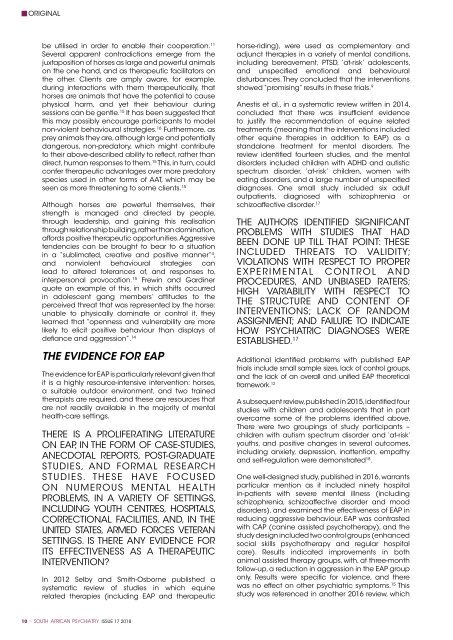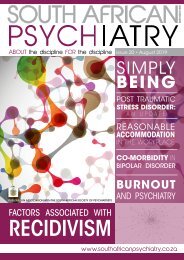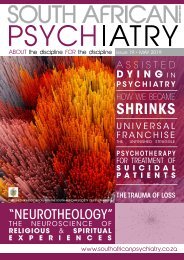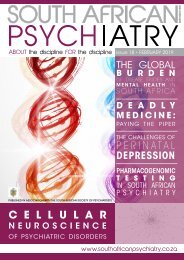South African Psychiatry - November 2018
South African Psychiatry - November 2018
South African Psychiatry - November 2018
You also want an ePaper? Increase the reach of your titles
YUMPU automatically turns print PDFs into web optimized ePapers that Google loves.
ORIGINAL<br />
be utilised in order to enable their cooperation. 11<br />
Several apparent contradictions emerge from the<br />
juxtaposition of horses as large and powerful animals<br />
on the one hand, and as therapeutic facilitators on<br />
the other. Clients are amply aware, for example,<br />
during interactions with them therapeutically, that<br />
horses are animals that have the potential to cause<br />
physical harm, and yet their behaviour during<br />
sessions can be gentle. 15 It has been suggested that<br />
this may possibly encourage participants to model<br />
non-violent behavioural strategies. 16 Furthermore, as<br />
prey animals they are, although large and potentially<br />
dangerous, non-predatory, which might contribute<br />
to their above-described ability to reflect, rather than<br />
direct, human responses to them. 15 This, in turn, could<br />
confer therapeutic advantages over more predatory<br />
species used in other forms of AAT, which may be<br />
seen as more threatening to some clients. 15<br />
Although horses are powerful themselves, their<br />
strength is managed and directed by people,<br />
through leadership, and gaining this realisation<br />
through relationship building, rather than domination,<br />
affords positive therapeutic opportunities. Aggressive<br />
tendencies can be brought to bear to a situation<br />
in a “sublimated, creative and positive manner” 4 ,<br />
and nonviolent behavioural strategies can<br />
lead to altered tolerances of, and responses to,<br />
interpersonal provocation. 15 Frewin and Gardiner<br />
quote an example of this, in which shifts occurred<br />
in adolescent gang members’ attitudes to the<br />
perceived threat that was represented by the horse:<br />
unable to physically dominate or control it, they<br />
learned that “openness and vulnerability are more<br />
likely to elicit positive behaviour than displays of<br />
defiance and aggression”. 14<br />
THE EVIDENCE FOR EAP<br />
The evidence for EAP is particularly relevant given that<br />
it is a highly resource-intensive intervention: horses,<br />
a suitable outdoor environment, and two trained<br />
therapists are required, and these are resources that<br />
are not readily available in the majority of mental<br />
health-care settings.<br />
THERE IS A PROLIFERATING LITERATURE<br />
ON EAP, IN THE FORM OF CASE-STUDIES,<br />
ANECDOTAL REPORTS, POST-GRADUATE<br />
STUDIES, AND FORMAL RESEARCH<br />
STUDIES. THESE HAVE FOCUSED<br />
ON NUMEROUS MENTAL HEALTH<br />
PROBLEMS, IN A VARIETY OF SETTINGS,<br />
INCLUDING YOUTH CENTRES, HOSPITALS,<br />
CORRECTIONAL FACILITIES, AND, IN THE<br />
UNITED STATES, ARMED FORCES VETERAN<br />
SETTINGS. IS THERE ANY EVIDENCE FOR<br />
ITS EFFECTIVENESS AS A THERAPEUTIC<br />
INTERVENTION?<br />
In 2012 Selby and Smith-Osborne published a<br />
systematic review of studies in which equine<br />
related therapies (including EAP and therapeutic<br />
horse-riding), were used as complementary and<br />
adjunct therapies in a variety of mental conditions,<br />
including bereavement, PTSD, ‘at-risk’ adolescents,<br />
and unspecified emotional and behavioural<br />
disturbances. They concluded that the interventions<br />
showed “promising” results in these trials. 9<br />
Anestis et al., in a systematic review written in 2014,<br />
concluded that there was insufficient evidence<br />
to justify the recommendation of equine related<br />
treatments (meaning that the interventions included<br />
other equine therapies in addition to EAP) as a<br />
standalone treatment for mental disorders. The<br />
review identified fourteen studies, and the mental<br />
disorders included children with ADHD and autistic<br />
spectrum disorder, ‘at-risk’ children, women with<br />
eating disorders, and a large number of unspecified<br />
diagnoses. One small study included six adult<br />
outpatients, diagnosed with schizophrenia or<br />
schizoaffective disorder. 17<br />
THE AUTHORS IDENTIFIED SIGNIFICANT<br />
PROBLEMS WITH STUDIES THAT HAD<br />
BEEN DONE UP TILL THAT POINT: THESE<br />
INCLUDED THREATS TO VALIDITY;<br />
VIOLATIONS WITH RESPECT TO PROPER<br />
EXPERIMENTAL CONTROL AND<br />
PROCEDURES, AND UNBIASED RATERS;<br />
HIGH VARIABILITY WITH RESPECT TO<br />
THE STRUCTURE AND CONTENT OF<br />
INTERVENTIONS; LACK OF RANDOM<br />
ASSIGNMENT; AND FAILURE TO INDICATE<br />
HOW PSYCHIATRIC DIAGNOSES WERE<br />
ESTABLISHED. 17<br />
Additional identified problems with published EAP<br />
trials include small sample sizes, lack of control groups,<br />
and the lack of an overall and unified EAP theoretical<br />
framework. 12<br />
A subsequent review, published in 2015, identified four<br />
studies with children and adolescents that in part<br />
overcame some of the problems identified above.<br />
There were two groupings of study participants –<br />
children with autism spectrum disorder and ‘at-risk’<br />
youths, and positive changes in several outcomes,<br />
including anxiety, depression, inattention, empathy<br />
and self-regulation were demonstrated 18 .<br />
One well-designed study, published in 2016, warrants<br />
particular mention as it included ninety hospital<br />
in-patients with severe mental illness (including<br />
schizophrenia, schizoaffective disorder and mood<br />
disorders), and examined the effectiveness of EAP in<br />
reducing aggressive behaviour. EAP was contrasted<br />
with CAP (canine assisted psychotherapy), and the<br />
study design included two control groups (enhanced<br />
social skills psychotherapy and regular hospital<br />
care). Results indicated improvements in both<br />
animal assisted therapy groups, with, at three-month<br />
follow-up, a reduction in aggression in the EAP group<br />
only. Results were specific for violence, and there<br />
was no effect on other psychiatric symptoms. 15 This<br />
study was referenced in another 2016 review, which<br />
10 * SOUTH AFRICAN PSYCHIATRY ISSUE 17 <strong>2018</strong>

















